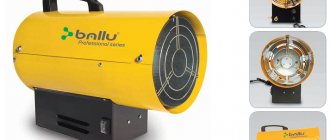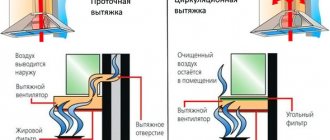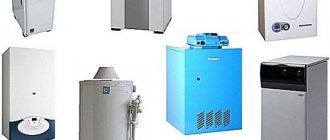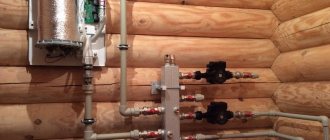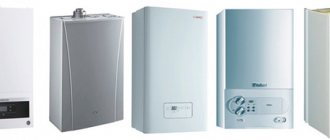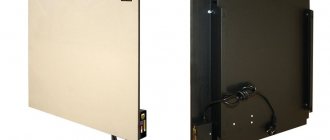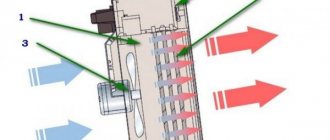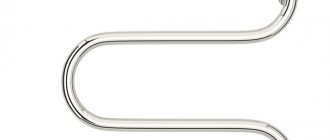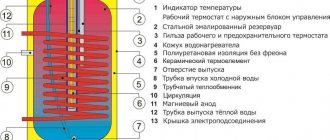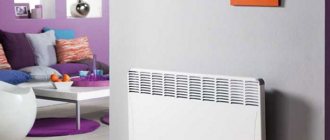Traditional water heating in our country is complex and expensive at the installation stage. Therefore, many are looking for other options for heating rooms, cottages, cottages and apartments. The first thing that comes to mind is electric heating convectors. Installation is super simple: set it up or hang it up, plug it into a power outlet. All. You can warm up. The only limitation is whether the wiring can withstand such a load. The second is decent electricity bills, but they can be reduced by installing a two-tariff meter.
Electric heating convectors can be the main or additional heat source
What is convection and convector
Convection is the process of heat transfer due to the movement of heated air. A convector is a device that heats air and promotes its movement. There are convectors in which heating occurs due to the circulation of coolant, then they are part of water heating. But we will talk about electric convectors, which convert electricity into heat, and air flows carry this heat throughout the room.
According to the installation method, convector electric heaters are wall-mounted, floor-mounted, in-floor (built in below floor level), baseboard and universal (installed on legs that come included or hung on the wall).
Convection heating principle
It is impossible to say which form of electric heating convectors is better. All forms are developed taking into account thermodynamics (at least, normal companies do this this way), so you base your choice only on your own preferences and on which design fits best into the design of the room. No one forbids installing electric convectors of different types in one apartment, house, or even in a room. The main thing is that the wiring can withstand.
The principle of calculating the thermal power of heating devices
The principle for calculating the need for heating devices is the same for radiators and convectors. If we are talking about a room with a standard ceiling height of 2.7 to 3.0 m, then maintaining a comfortable temperature in the range of 19 - 22 C is ensured when 100 watts of heat are supplied per 1 sq. m.
The difference between convector and radiator heating is only in the principle of heat transfer, and the energy requirement of the room for heating remains the same. When calculating, you can resort to a complex integrated methodology that is used by design specialists. It takes into account a large number of factors, so it is used for large objects, where the total number of losses in all apartments and premises adds up to large amounts.
Choosing an installation location
Or rather, the question is not this: which convector is suitable for fulfilling your wishes. If you want to bring the appearance of the room closer to the standard one, you can hang rectangular wall convectors under the windows. Models that can be installed under the ceiling attract a little more attention, but they are inaccessible to children and pets - they will not be able to get burned or “adjust” in their own way. The installation method is the same here - on brackets fixed to the wall. Only the shape of the brackets differs.
You can choose any location for installing the electric convector. It is only advisable that it is not covered by furniture
If you want your heating appliances not to be visible, you will have to choose between baseboard and in-floor models. There is a big difference in installation: skirting boards are simply installed and connected to the network, but for in-floor ones you will have to make special recesses in the floor - their top panel should be on the same level as the finished floor. In general, you cannot install them without major repairs.
These are floor-mounted convectors. They are also electric
heating elements
Next you should pay attention to the heating elements. Needle-type heating elements, where the spiral is not protected by anything and is fixed on a thin plate, are very fragile; a small blow to the body is enough for the spiral thread to break.
POPULAR WITH READERS: Electric heating at home - which is better: boilers or air convectors
But such convectors are much cheaper than with other types of heaters.
The most reliable and durable are monolithic heating elements. They are not afraid of shocks and can even withstand the device being tipped over. However, the cost of devices with heating elements is much higher.
The choice of monolithic heating elements is also supported by the operation of the convector itself.
Needle-type heaters may crackle slightly during operation, while monolithic heaters are absolutely silent.
Power calculation
If a convector is needed only as an additional source of heat - for periods of extreme cold - it makes sense to take a couple of low-power devices - 1-1.5 kW each. They can be moved to those rooms where the temperature needs to be raised. If convector heating is the only source of heat, everything is much more serious.
This is approximately how you can calculate the power of convectors
If you do everything “wisely,” you need to calculate the heat loss of a house or apartment and select equipment based on the calculation results. In fact, this is very rarely done. Much more often they calculate the required heating power by area: 10 square meters for heating. m area requires 12 kW of heat. But these are the norms for average ceiling heights - 2.50-2.70 m and average insulation. If the ceilings are higher (the volume of air needs to be heated) or there is “no” insulation at all, the power is increased by 20-30%.
How to calculate the power of a heating convector? 1. by area or 2. thermal calculation of the room?!
Convectors are the main heating devices for heating residential, public premises and industries. Most often, when installing high-quality internal heating, the choice falls on convectors, since they provide a highly efficient and uninterrupted heat source capable of heating rooms of any purpose and size.
An important factor after choosing the type of convector is calculating its power.
Let's consider 2 options for calculating the power (W) of the convector
The selection is based on the area of the room. (not a competent approach, overpayment by 2-3 times)
This option for calculating the power of a convector is not correct (explanation at the end of the section), but it is often used and therefore we will consider it too.
To make calculations, you will need to collect the necessary data, on which the correctness of the results will depend.
What determines the calculation of convector power?
Calculating the optimal power rating of a heating device for a home is not an easy task. In this case, it is important not to be lazy in making calculations and manipulating with numbers, because only this will help determine the golden mean specifically for your premises. Too high a device indicator becomes the main reason for high cash costs, a deficiency, in turn, leads to a lack of the required amount of heat.
When independently calculating the power of a heating device, the following factors must be taken into account:
- convector type;
- purpose of the premises;
- number of windows in the room;
- ceiling height;
- the presence of another type of heating;
- number of external walls;
- presence of thermal insulation, type of glazing.
To avoid errors in calculations, it is important to take into account all the details of the location of the room. It is preferable to seek professional help, but if this is not possible, you can do it on your own, relying on basic calculation methods.
Power calculation formula
Calculating power by area is the simplest because it requires minimal knowledge. The standard formula for such a calculation states that for heating 10 sq.m. area typically requires 1 kW of thermal energy. But this formula is not correct today, since it was used in the 50-60s in the construction of multi-story buildings from the same materials. The use of such a calculation made it clear what approximate heating power could be taken for the construction of a district boiler house.
Since the 90s, there have been changes in building codes, and the main change concerns the energy efficient construction of multi-story buildings. This has resulted in warmer building facades and reduced heating costs. Formula 1 kW per 10 sq.m. has become irrelevant.
Exceptions where the thermal energy factor may change include:
- corner location of the room - 1.2 kW;
- no external wall insulation – 1.1 kW;
- windows made of single-layer double-glazed windows - 0.9 kW;
- high ceilings (from 2.8 to 3 m) – 1.05 kW;
- high-quality thermal insulation, triple glazing - 0.8 kW.
Ideally, the calculation takes into account such details as the presence of an entrance door, the wind rose, as well as the optimal ratio of flooring area to windows. It follows from this that the optimal power indicator for a built-in room is 20 sq.m. with standard heat loss, ceiling height of 2.7 m and single glazing is 2 kW.
Simple calculation table
To determine the optimal power of the convector, you can use the universal power table for the area of the heated room, taking into account the height of the ceilings and important placement factors:
| room area | power in kW taking into account: | ||||
| ceiling height 2.7 m | ceiling height 2.8 m | ceiling height 2.9 m or more | 1 external wall | 2 external walls | |
| 10 | 1 | 1,12 | 1,16 — 1,2 | 1kW | 1.2kW |
| 15 | 1,5 | 1,68 | 1,74 — 1,8 | 1.2kW | 1.3kW |
| 20 | 2 | 2,24 | 2,32 — 2,4 | +10% | +10% |
| 25 | 2,5 | 2,8 | 2,9 — 3 | +15% | +15% |
| 30 | 3 | 3,36 | 3,48 — 3,6 | +20% | +20% |
Using the table presented above, you can easily select the required power for the convector. When placing a room in a corner, it is important to apply an increasing factor of 1.1 to the presented parameters; if there is reliable thermal insulation in the room - 0.8.
So, a description of this method from a scientific point of view:
Calculation of power by room area is applicable, but!!! This method was used previously and is used now only during the construction of a district, microdistrict, mini-towns, etc., in a certain region. It is used to determine the capacity of a district boiler house or ITP.
When construction is underway from the same type of material and the volume of construction has been determined, they take 1 house, perform a thermal calculation and calculate the heat loss per 1 sq.m.
For individual or private construction, this method is not applicable, since all buildings are made of different materials.
Using this method, you will never determine how much heat you need to supply to the room to heat it. You will either overpay for heating, there will be excess heat, or it will be cold in your house or apartment in winter.
Selection of convectors using thermal engineering calculations of external fences.
At first glance, this method seems complicated, but in fact you don't need to rack your brains over it.
When you purchase a convector or other heating device, you just need to check with the seller the following: What power does this or that device produce (W) and at what coolant temperature (for water heating systems)?
If you can get such information, then it’s good and you can continue the dialogue; if you can’t tell, then it’s better to go elsewhere to purchase a heating device.
So, suppose you have received an answer to the question, what to do next?:
- You need to have a plan or project with the dimensions of the rooms and windows;
- Find out the temperature of the coolant in your heating system; for apartments, this is provided by the management company; for private houses, when purchasing a heating boiler, its technical characteristics contain such information.
Let's consider the option with apartments, since a private house requires a more professional approach in the field of heat and power engineering.
You just need to find out what the outer walls in the apartment are made of. The management company or builder with whom you will make repairs will help you in this matter.
In modern construction, there are several types of external walls in multi-storey buildings:
- The wall material is homogeneous;
- Multilayer with insulation;
- Ventilated facade;
- Glass.
Having this information, you can contact the same company where you are going to purchase a heating device and ask them to make a selection taking into account the above data.
If they couldn’t help you for some reason, then don’t be upset, not all sellers in the heating field understand this issue, it’s better to go where there are professionals.
When you have managed to find a common language with the seller or engineer, you can safely buy a convector or other heating device.
This method guarantees 95-100% that you bought a heating device that suits you and did not overpay 2-3 times.
Manufacturers, characteristics and prices
Electric convector heaters are produced by several companies that produce other household appliances - Electrolux, AEG, Hyundai, Stiebel Eltron, Zanussi. In addition, there are many companies that specialize in this type of technology or produce two or three more groups of products. Among them there are Russian manufacturers - Ballu, Termica, Ural-Mikmah-Term, Alvin. There is also a whole group of European brands:
- Airele, Noirot and Atlantic (France),
- Extra, Royal Thermo, Scoole, Timberk, WWQ (PRC),
- Frico (Sweden),
- NeoClima (Greece),
- Nobo (Norway)
and many more. Electric heating is the norm in Europe; water heating is rare here. Hence the number of companies producing such household appliances. But, as is usual in recent years, most companies have moved production to China, so the assembly is mainly Chinese, although quality control should be at the level.
Electric heating convectors can have a power from 0.5 kW to 2.5-3 kW. They operate mainly from a 220 V network; if necessary, three-phase ones can be found - from 380 V. With increasing power, the dimensions (mainly depth) and price increase. If we talk about prices on average, then the price for imported electric convectors is about $80-250, for Russian ones - $30-85.
| Name | Power | Additional functions | Installation type | Control type | Heating element type | Dimensions (D*W*H) | Price |
| AEG WKL | 0.5/1/1.5/2/2.5/3 kW | overheat protection | Wall | Thermostat | heating element | 78*370*450 | 105 — 195 $ |
| Airelec Paris digital 05DG | 0.5 kW | overheat protection | Wall | Electronic | Monolithic | 80*440*400 | 60-95 $ |
| Termica CE 1000 MR | 1 kW | Overheat protection + ionizer | Floor | Thermostat (mechanical) | heating element | 78*400*460 | 50 $ |
| Nobo C4F 15 XSC | 1.5 kW | Overheat and tip-over shutdown | Wall/floor | Electronic | heating element | 55*400*975 | 170 $ |
| Stiebel Eltron CS 20 L | 2 kW | Overheat protection + fan | Floor | Thermostat (mechanical) | spiral heating element | 100*437*600 | 200-220 $ |
| Stiebel Eltron CON 20 S | 2 kW | overheat protection | Floor | Thermostat (mechanical) | Stainless steel heating element | 123*460*740 | 450 $ |
| Noirot Melodie Evolution1500 | 1.5 kW | Overheat and tip-over shutdown | Wall-mounted (small height) | Electronic | Monolithic | 80*220*1300 | 300-350 $ |
| Ballu BEC/EVE – 1500 | 1.5 kW | Overheat and tip-over shutdown | Wall/floor | Electronic | Heating element Double G Force | 111*640*413 | 70 $ |
| Timberk TEC.PF1 M 1000 IN | 1 kW | Overheat and tip-over shutdown + ionizer | Wall/floor | Thermostat (mechanical) | Needle + quiet + economical | 100*410*460 | 65 $ |
| Dantex SD4-10 | 1 kW | Overheat and tip-over shutdown | Wall/floor | Electronic | Needle + quiet + economical | 78*640*400 | 45 $ |
Useful additional features
When choosing electric heating convectors, pay attention not only to technical parameters. There are also additional functions that increase comfort and safety:
- Overheat protection. An additional sensor is installed on the case, which turns off the power when a threshold value is reached. Usually it is +60°C.
- Drop shutdown. This function is relevant for models with floor-mounted installation. If the position changes (falls or bends too much), the power turns off. This function prevents possible fires.
- Restart. When turned on again, the electric convector automatically sets the settings that were when it was turned off.
Skirting-type convector - very low and long
Overheat protection and drop shutdown are very useful features that increase the safety of the equipment. Something else you can pay attention to is how quiet or loud the unit is. It's not just the heating element (it usually clicks). When activated, the mechanical thermostat also clicks. When choosing convection heaters for your bedroom, quiet operation is very important.
Types of convector heaters
Structurally, all convector heaters are very similar, but several types are produced - wall-mounted, free-standing, floor-mounted and for rooms with high humidity.
They can be divided into high ones - with a height of up to 650 mm, and low ones - up to 200 mm.
Wall-mounted and free-standing are classified as high. The difference between them comes down to the fact that wall-mounted ones are equipped with lugs for mounting on the wall, making them stationary and providing heating only for the room where they are installed.
Free-standing - they have legs with wheels at the bottom, which allows them to be moved if necessary, providing warmth in different rooms.
A feature of this type of heaters is the high heating of the heating element, which, in combination with a high body, ensures high air circulation, which ensures their high thermal efficiency.
Floor heaters are made slightly differently, although their design is identical. They are not high, they are also called “plinth”.
But their width is much greater. Some models reach a width of 3000 mm.
Essentially, this is the same convector, but located horizontally. The large length and width, while its low location allows the heating elements to heat up less to achieve the required temperature, since they heat the lower layers of air more efficiently.
POPULAR WITH READERS: Grounding systems advantages and disadvantages
I often install such heaters under window openings.
The inconvenience of using floor heaters comes down to the same width. They take up more floor space, which leads to the possibility of frequent kicking.
Although some home owners, during construction, pre-allocate niches in the floor for installing such heaters, and then protect them with a grille.
Underfloor electric heating convector ESK series.
The types of convectors described above have one feature - they cannot be used in rooms with high humidity levels.
However, special versions of convectors are produced - waterproof. In such heaters, all internal elements are protected from moisture and can be used in any room.
